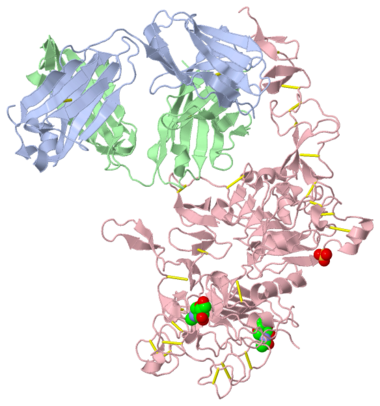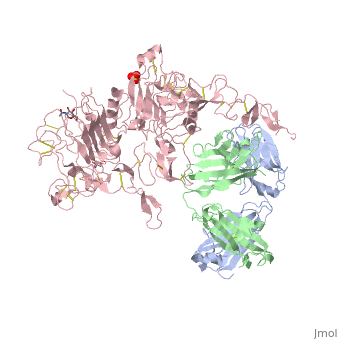Herceptin - Mechanism of Action
From Proteopedia
| Line 12: | Line 12: | ||
<StructureSection load='1n8z' size='350' side='right' caption='Crystal structure of extracellular domain of human HER2 complexed with Herceptin Fab (PDB entry [[1n8z]])' scene=''> | <StructureSection load='1n8z' size='350' side='right' caption='Crystal structure of extracellular domain of human HER2 complexed with Herceptin Fab (PDB entry [[1n8z]])' scene=''> | ||
| - | == ''' | + | == '''HER2''' == |
''ERBB2'' is located on the long arm of human chromosome 17 (17q12). This gene codes for the protein HER2 and is known as a proto-oncogene due to its ability to become an oncogene from an over-expression. | ''ERBB2'' is located on the long arm of human chromosome 17 (17q12). This gene codes for the protein HER2 and is known as a proto-oncogene due to its ability to become an oncogene from an over-expression. | ||
| Line 28: | Line 28: | ||
*phospholipase C | *phospholipase C | ||
*protein kinase C (PKC) | *protein kinase C (PKC) | ||
| + | |||
| + | HER2 structure differs in that sub-domains I and III are in constant contact resulting in a permanent open conformation. Sub-domains I and III in HER2 are stabilized by core hydrophobic residues surrounded by hydrophilic contacts facilitating the stabilization of this interaction. This fixed conformation allows the receptor to act in a ligand-independent manner and permits the access of sub-domain II for dimerization. Perhaps this may explain why a high-affinity ligand for HER2 has not yet been recognized. The absence of sub-domain II and IV contact can be explained by the mutations of Gly 563 and His 565 found in the other members of the HER family to Pro and Phe respectively. Since sub-domain II is always available for dimerization it is free to form heterodimers with any of the other epidermal growth factor receptors; it does not form a homodimer. Asp 285 is the only residue in sub-domain II not conserved between EGFR and HER2. Leu replaces Asp 285 in HER2 and can explain why HER2 does not form homodimers. Once dimerized, HER2 activates the MAPK pathway, which in turn initiates cell proliferation, migration, differentiation, and angiogenesis. | ||
| + | |||
| + | HER2 also has another potentially harmful ability. The juxtamembrane region of the extracellular domain is prone to proteolytic cleavage resulting in a protein called p95HER2. p95HER2 is the truncated form of HER2 and has been shown to have an increased ability to cross-phosphorylate with the other receptors of the HER family and has increased cellular signaling capabilities. | ||
| + | |||
| + | One combination of epidermal growth factor receptors has the potential to be a potent inducer of tumorigenesis. HER2:HER3 combination can be especially detrimental to a patient exhibiting over-expression of HER2. While HER2 activates a cell proliferation pathway, HER3 is the only receptor that can directly activate the PI3K pathway. The PI3K pathway recruits its messengers (Akt and mTOR) that allows for the activation of cell survival mechanisms and helps the cell resist apoptosis. This combination can become deadly resulting in metastasized cancer. | ||
| + | |||
| + | == '''Herceptin''' == | ||
| + | |||
| + | Herceptin is a monoclonal antibody proven to be a clinically effective treatment in fighting HER2+ breast cancer. There is also some clinical evidence suggesting that Herceptin enhances the effects of chemotherapy. Herceptin binds to the juxtamembrane region of HER2 on the C-terminal portion of sub-domain IV. The interaction formed by Herceptin and HER2 is mediated by three regions on HER2 that form three loops: residues 557-561 (loop 1), 570-573 (loop 2), and 593-603 (loop 3). Loops 1 and 3 are formed primarily by electrostatic interactions and loop 2 is formed by hydrophobic contacts. Herceptin acts by four different mechanisms of action: | ||
| + | *activation of antibody-dependent cellular cytotoxicity | ||
| + | *prevention of formation of p95HER2 | ||
| + | *inhibition of cell proliferation | ||
| + | *inhibition of angiogenesis | ||
| + | |||
| + | When Herceptin binds to HER2 it is able to flag these cells for destruction. This works by | ||
| + | attracting lymphocytes to these HER2+ cells. Lymphocytes are then stimulated to release substances that cause cellular apoptosis. | ||
| + | |||
| + | An added significant mechanism of action of Herceptin is the prevention of the formation of p95HER2. By binding to the juxtamembrane region Herceptin sterically hinders any cleavage of the site ultimately preventing the formation of the highly active p95HER2. | ||
| + | |||
| + | The next two mechanisms of action for Herceptin involve intracellular inhibition. By the binding of Herceptin to the extracellular region of HER2 Herceptin is able to prevent downstream activation of cell signals that induce cell proliferation and angiogenesis. Repression of the proangiogenic factors Herceptin is also able to induce antiangiogenic factors. By inhibiting these intracellular processes Herceptin prevents any further blood vessels developing towards the tumor and prevents the tumor from growing any larger. | ||
| + | |||
| + | One limitation with this therapy is that it does not prevent HER2 from dimerizing with HER3. This makes it possible for the activation of the PI3K pathway which increases the ability of the cell to survive. Further therapies targeting the prevention of HER2 to dimerize with other members of the HER family will be necessary for future investigational studies. | ||
| + | |||
| + | |||
| + | |||
</StructureSection> | </StructureSection> | ||
Revision as of 19:18, 31 October 2012

Contents |
Basics
Breast cancer is the most common type of cancer found among women. Although it is rarely seen in men, one in eight women will be diagnosed with breast cancer within their lifetime. Patients exhibiting an over-expression in Human Epidermal Growth Factor Receptor 2 (HER2) account for 25% of all breast cancer. HER2+ patients often experience a more aggressive cancer resulting in more metastasized tumors. The statistics show a poor prognosis for HER2+ patients with a 5-year survival rate of 68%. Herceptin (also known as trastuzumab) was approved by the FDA in September of 1998 for HER2+ patients and has been shown to be an effective tool in the battle against breast cancer. HER2 is one of four human epidermal growth factor receptors (EGFR , HER2, HER3, and HER4). These receptors are part of a family of receptor tyrosine kinases responsible for cell proliferation and differentiation. This family is known as the ErbB family; being that these proteins are encoded by the ERBB genes. The ErbB family are plasma membrane-bound and contain an extracellular ligand-binding domain, a transmembrane domain, and an intracellular domain.
These human epidermal growth factor receptors exist on the cell surface and, with the exception of HER2, bind to specific ligands (epidermal growth factors). Over 11 different ligands for the Epidermal Growth Factor Receptors have been identified. After binding with these ligands the receptor tyrosine kinases are able to homo-dimerise (with the exception of HER2) or hetero-dimerise with one another. This dimerization causes a cross-phosphorylation between the two receptors and ultimately activates a cell signaling pathway causing cell division.
HER2 is the only receptor within this family that is constitutively active being able to dimerise with other receptor tyrosine kinases acting in a ligand-independent manner. This continuous activation of the cell signal pathway causes an increase in cell division; thus, potentially causing a tumor.
Herceptin, generic trastuzumab, is a monoclonal antibody. Herceptin is an effective treatment for breast cancer for the reason that it binds to the extracellular domain of HER2 and, by multiple mechanisms of action, can prevent cell proliferation as well as target these HER2+ cells for destruction by the immune system. By these mechanisms Herceptin is an effective treatment for breast cancer.
| |||||||||||

